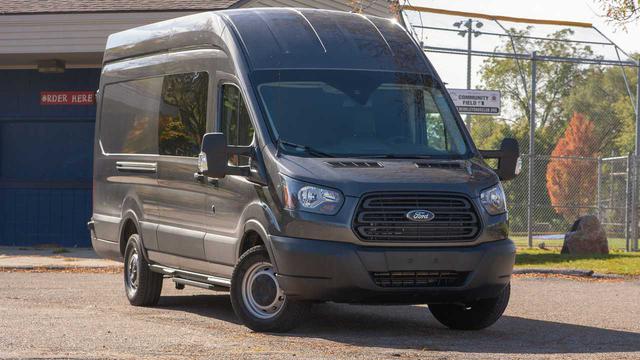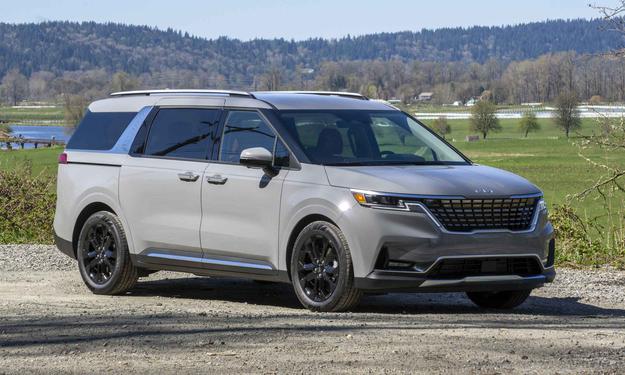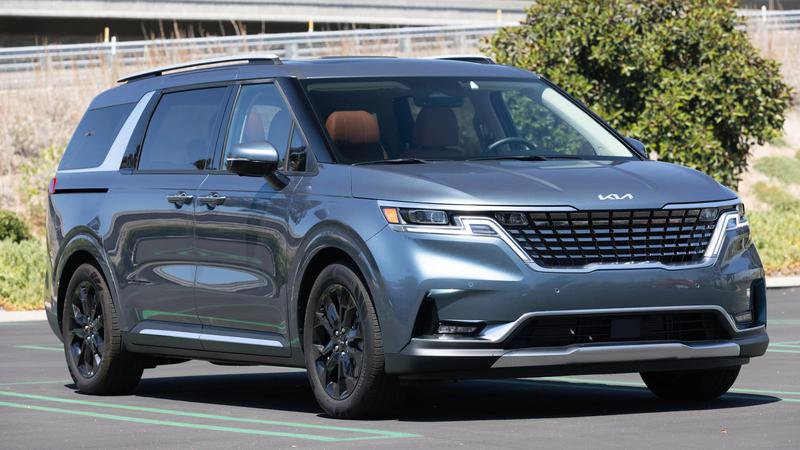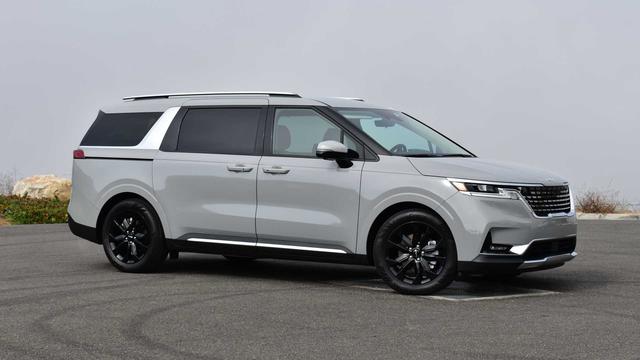I won't lie: moving sucks. And you're probably no stranger to this necessary evil of life. However, you probably are a stranger to schlepping your home across the country. At least doing so three times. The zig-zag that is my 30s has taken me from Los Angeles to Washington, D.C., to Irvine, California, to Brooklyn, New York. At least now I've only moved halfway across the country, to Ypsilanti, Michigan, about 45 minutes west of Detroit.
In any case, it's not the why that's important but the how. For my previous cross-country treks, I packed what I could into my compact car and drove the 2,500 miles while a moving company followed suit with the rest of my belongings. This time around I had the services of a 2018 Ford Transit 250 of the medium-roof height and long-wheelbase (LWB) variety.
Advertisement
The standard Transit 150 is 81.3 inches tall, sits on a 129.9-inch wheelbase, and measures 219.9 inches in length. A LWB version like mine has a 147.6-inch wheelbase and is 235.5 inches long. An available high roof-only extended version adds another 28.4 inches to stretch to 263.9 inches.
Basically, this thing is huge.
Advertisement
But after four addresses (ugh, subletting) in my three-plus years of NYC living, moving should be easy peasy, right? No. Never. Instead of departing Prospect Park South by noon on move-out day, I depart at 8 p.m. The packing had long been done so mid-day didn't seem that ambitious a target, but the loading took some elite-level Tetris mastery. Not because of any complexity on the part of the Ford but because not everything fits nicely into a box.
My one-bedroom apartment was roughly 600 square feet – massive by NYC standards. But I didn't think I owned much, and I had been purging during the weeks leading up to now. Lolz. My assessment was quickly proven very, very wrong. I lost count of how many times I went up and down the elevator with the hand truck, taking the stairs only for what couldn't fit, like my sectional. For a fun visual, imagine people 6'4" and 5'2" carrying a chaise longue down five flights.
I had already fit about 20 small- and medium-sized boxes into my Mazdaspeed3 hatchback, which I had driven out the previous week. But the car holds 42.8 cu.-ft. with the rear seats folded. The Transit 250, by comparison, has 357.1 cu.-ft. of cargo capacity behind the front seats. Take the front passenger seat out for up to 405.6 cu.-ft. Oh, my. So much space but also so much stuff.
Finally – and despite a constant but light drizzle – the sectional, a queen-size mattress and box spring, a set of winter tires, two 5-shelf bookcases, two shoe closets, a coffee table, an end table, and a stuffed 6-foot-long padded snowboard carrier were loaded. But wait. Of course, there's more!
My desk and bed were broken down and packed in with about two dozen more boxes of various sizes. I even created a shelf by balancing the mattress atop the stacked sectional and box spring. And still I didn't fit everything! My wine cooler, another bookcase, and an office chair were gifted to my building super. (You're welcome, Cesar.)
But as the sun was slowly setting on my last day in BK, I was ready to leave. And I was scared. Did I forget anything? Did I input the correct address into the navigation? Do I have enough gas? Is this move the right idea? Should I chug an energy drink? Am I going to be able to control this behemoth? No, yes, yes, no idea, obviously, and Godspeed were the answers.
Now, driving through the one-way streets of my neighborhood before reaching the expressway was going to be a good starting test. Standard power in the Transit 250 is a 3.7-liter V6 with an output of 275 horsepower and 260 lb.-ft. of torque, but Ford provided me a van with a bit more muscle. Equipped with a 3.5-liter V6 EcoBoost engine, my vehicle was capable of 310 hp and 400 lb.-ft. of torque.
Paired with a standard 6-speed automatic transmission, I wasn't worried about movability as opposed to maneuverability of a vehicle that was most likely close to its maximum gross vehicle weight, which is 9,000 lbs. for this model. I mean, it certainly felt like I was lugging around an unwieldy max payload of 3,730 lbs. But there was no time to wonder, so off I went!
Into the curb.
A mere 30 yards from where I started, I kissed the first corner. Although I brushed the rubber and not the 16-inch silver wheel covers, scrubbing anything was not a happy harbinger. The expressway was a usual car crawl but crossing the Brooklyn Bridge was no sweat as was merging onto the now empty streets of downtown. But turning onto Canal Street in Chinatown was about as fun as my first turn, and with more pedestrians.
After about 40 minutes of careful city driving, NYC was gone. Literally. My rearview mirror was pointed directly at my wedged-in desktop. I couldn't see anything beyond the windshield, outside mirrors, and rearview camera. But little did I know that wide turns around pedestrians would be the least of my worries. Hello, New Jersey Turnpike.

I'd always considered on-ramps as life's little pleasures. Not tonight. For every ramp and roundabout were now harrowing adventures in physics. Length was no longer my concern. Heft was. Adhering to posted limits was life-dependent. Sure, it may have all been in my head but one off-camber anything and I thought I was going to fall over like a half-asleep bovine. And if I wasn't careful, this tipping would not be an urban legend.
Advertisement
One hour into the 270-mile drive to my hotel in Clearfield, Pennsylvania, I was a wreck. Then, as if the NYC gods were telling me to just turn around and go back, the downpour came. And the fog. And the schizophrenic rain-sensing wipers.
Mist or rain, I wasn't sure of the wipers' preference, so I set it to the speed of fast as the rain and fog didn't let up for three hours. Forget pea soup. It was more like lentil stew with the darkness broken up occasionally only by the hazy glow of taillights and headlights. Without them, I could barely make out the lane markings.
On a positive note, there are 10 cupholders in the Transit. Two in each front door, two built into each end of the dashboard, and two within the center console. Utilizing the six within reach, I strategically arranged my phone, water, energy drinks, and snacks. I can even confirm that the door and dash cubbies were perfect for safekeeping bottles of wine. (Hey, just because I gave away the fridge doesn't mean I had to relinquish the wine, too.) Surprisingly, a 16-ounce beverage can didn't enjoy the same snug comfort as it sloshed about during turns and turnpikes, as slowly as they were approached.
Exhausted, I reached the hotel at 1 a.m. And although the 47.8-foot turning radius of the LWB model is more than competitors, the Transit didn't feel at all cumbersome while looping around the parking lot and reversing into a corner pocket. Unable to see out of the rear windows, the rearview camera was a must, though.
In fact, rear windows are optional, and most Transit vehicles are ordered without them. Regardless, the rearview camera is standard across the lineup and is now high-mounted for medium- and high-roof 2018 models. On-screen guidelines and the optional audible proximity alert were welcome extras on my vehicle. A backup alarm to alert pedestrians and other motorists is also available.
Advertisement
Following a short slumber and with a belly full of biscuits and gravy, I was back on the road. After all, I was only halfway to my lease-signing appointment. Thankfully, the weather was more amenable with warm but mostly sunny skies. Which means more time to focus on the Ford and its faults. Like those wipers, which apparently converted to sunshine-sensing. At this point I left them on for the sheer amusement.
Advertisement
The Transit is every bit utilitarian and flexible as a daily workhorse, but as a daily driver, I want to scream. Its ergonomics are appalling. My short legs mean I sit closer to the steering wheel. Yet even so, I found myself reaching for items placed within the dashboard's top cupholder. I'm practically sitting within the instrument panel but still must lean forward to grab anything? That's just baffling.
Additionally, the optional 6.5-inch touchscreen display might work in a sedan, but not a cargo van, or even a minivan. It's simply too small. With the steering wheel featuring only basic controls for cruise control, Bluetooth, and IP operation, other features like navigation, audio, and apps (as part of Ford's Sync 3 infotainment system) had to be operated with the too-far-away and too tiny touchscreen.
To make things even more awkward, the center console is positioned dead center with nary a degree angled toward the driver. Truth be told, I found it easier (but no more user friendly) to input information while sitting directly in front of the screen. Therefore, you can imagine how often I'd miss my intended icon while driving and the annoyance that followed.
But it's not all maddening. Optioned with 10-way power-adjustable front seats, the leather upholstery was comfortable during every mile of my drive. Body aches are unavoidable when hiring yourself as moving labor but were alleviated thanks to the well-cushioned cabin.
And to reiterate, engine power was no issue. Without weather in the way, and with my own increased confidence behind the wheel, the Transit picked up speed considerably well for its plus-all-my-stuff weight and maintained highway speeds with little resistance. The brakes were also more than adequate when having to slow down abruptly.
Finally in Ypsilanti, the rainy-day theme returned with an added dose of Midwestern humidity (i.e., high). Because why should moving ever be easy or enjoyable? Sigh. With the cargo cavern eventually empty, I could see where two days of wet weather left its muddy mark. Yet with just a broom and several wet mopping pads, cleanup of the spray-on floor liner and plastic wall paneling was a cinch.
Now with a hollow core, the Transit acted like a completely different vehicle around town. It was loose and loud like a drunken Mardi Gras reveler but not nearly as much fun. When the cargo area was filled, my furnishings acted as sound-deadening material. Now the newly uncovered echo chamber exposed a remix of road noise and flexing metal. It wasn't bad per se; just noticeable. Still, this van will contain cargo during most of its lifetime, so some outside noise is really a non-issue.
Most Read
But at $44,815 (including $1,395 destination), a 2018 Transit 250 seems a bit pricey. While Sync 3, navigation, a power running board, and leather seating are expected to be add-ons, cruise control, rear privacy glass, and a backup alarm shouldn't be. Considering the majority of the Transit vehicles on the road are outfitted sans rear windows, any kind of backup assistance should be included.
For 2019, 4G LTE connectivity will be standard, but blind-spot monitoring with rear cross-traffic alert will be optional. The availability of these features should be reversed. I'd also like to see 360-degree view capability added someday. When compact crossovers can be equipped with them, why not larger vehicles that inherently have larger blind spots?
The EPA also doesn't require fuel economy ratings for this segment, but Ford approximated 15 city, 19 highway, and 16 combined mpg for my vehicle. With 657 miles driven, the vehicle readout was 17.8 combined mpg. In the end, for what I needed the Ford Transit to do, it delivered. And once I learned the nuances of how fast and how high to take an on-ramp or how wide to handle a curb, drivability wasn't as daunting as first impressions suggested.
So, as cargo vans go, the Transit lives up to expectations and, whether you're moving furniture or flowers, can tackle the tasks. Not that I'm in a hurry to move again (if ever). But if I do, I'd much rather be behind the wheel of a cargo van than a purpose-built 10-foot-plus moving truck. I mean, how much stuff should a person own anyway, right? Right.
Recommended on Daily News




